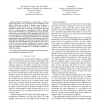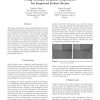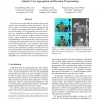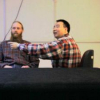CRV
2011
IEEE
13 years 7 months ago
2011
IEEE
—When reconstructing a specific type or class of object using stereo, we can leverage prior knowledge of the shape of that type of object. A popular class of object to reconstru...
ICCV
2011
IEEE
13 years 7 months ago
2011
IEEE
Images taken from scenes under water suffer distortion due to refraction. While refraction causes magnification with mild distortion on the observed images, severe distortions in...
ICPR
2010
IEEE
14 years 10 months ago
2010
IEEE
Segmentation is a low-level vision cue often deployed by stereo algorithms to assume that disparity within superpixels varies smoothly. In this paper, we show that constraining, o...
ICRA
1999
IEEE
14 years 11 months ago
1999
IEEE
This paper presents a trinocular stereo algorithm that we have developed as part of an obstacle detection system that detects small obstacles at long range on the highway. We desc...
ICRA
2002
IEEE
15 years 2 days ago
2002
IEEE
This paper describes the design and implementation of an algorithm for improving the performance of stereo vision in environments presenting repetitive patterns or regions with re...
EMMCVPR
2005
Springer
15 years 20 days ago
2005
Springer
Traditional stereo algorithms either explicitly use the frontal parallel plane assumption by only considering position (zero-order) disparity when computing similarity measures of ...
3DPVT
2006
IEEE
15 years 1 months ago
2006
IEEE
We present a stereo algorithm that achieves high quality results while maintaining real-time performance. The key idea is simple: we introduce an adaptive aggregation step in a dy...
ECCV
2004
Springer
15 years 9 months ago
2004
Springer
Abstract. We investigate the influence of the mirror shape on the imaging quality of catadioptric sensors. For axially symmetrical mirrors we calculate the locations of the virtual...
ICCV
2003
IEEE
15 years 9 months ago
2003
IEEE
A new algorithm is proposed for novel view generation in one-toone teleconferencing applications. Given the video streams acquired by two cameras placed on either side of a comput...
CVPR
2003
IEEE
15 years 9 months ago
2003
IEEE
In this paper a stereo algorithm suitable for implementation on commodity graphics hardware is presented. This is important since it allows to free up the main processor for other...




